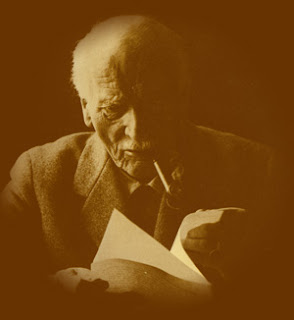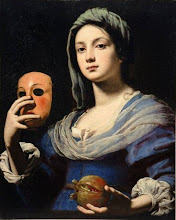
~ Padamalai, Teachings of Sri Ramana Maharshi Recorded by Muruganar
Refuting the mystical, metaphysical concept of the existence of individual, discrete selves (while bearing in a non existent mind, that there is no universally accepted theory as to what the word "existence" means)



"Be wherever you like, do whatever you choose, remember this well that all that you do is known to Me. I am the Inner Ruler of all and seated in their hearts. I envelope all creatures. I am the Controller - the wire-puller of the show of this Universe. I am the Mother - origin of all beings - the harmony of the three gunas (attributes), the propeller of all senses, the Creator, Preserver, and Destroyer. Nothing will harm who turns his attention towards Me,
but Maya (Illusion) will lash him who forgets Me. All the insects, ants, the visible, movable and immovable world is My body or form.""You need not go far, or anywhere in search of Me. Barring your name and form, there exists in you, as well as in all beings, a sense of Being or Consciousness of Existence. That is Myself. Knowing this, you see Me inside yourself as well as in all beings. If you practise this, you will realize all pervasiveness and thus attain oneness with Me."

Even the idea of a single Self is a mental concept.
It is neither true nor untrue.





"[Iris] Murdoch's ethical vision was based upon a concept which she, after Simone Weil, called attention. Attention, Murdoch proposed, is an especially vigilant kind of looking. When we exercise a care of attention towards a person, we note their gestures, their tones of voice, their facial expressions, their turns of phrase and thought. In this way, by interpreting these signs, we proceed an important distance towards understanding the hopes, wishes and needs of that person. This attention, Murdoch noted, is the most basic and indispensable form of moral work. It is effortful, but its rewards are immense. For this attention, she memorably wrote, 'teaches us how real things can be looked at and loved without being seized and used, without being appropriated into the greedy organism of the self'. Murdoch's ideal of attention, of a compelling particularity of vision, obtains to landscapes as well as to people. It is harder to dispose of anything, or to act selfishly towards it, once one has paid attention to its details. This is an environmentalist's truth, as well as a humanist's."- Robert Macfarlane
"Saccidānanda or Sat-cit-ānanda (Sanskrit: सच्चिदानंद) is a compound of three Sanskrit words, Sat (सत्), Cit (चित्), and Ānanda (आनंद) (the ā is of longer vocal length), meaning True Being, Pure Consciousness and Bliss respectively. The expression is used in Yoga and other schools of Indian philosophy to describe the nature of Brahman as experienced by a fully liberated yogin. Orthography may differ depending on whether the word is treated in its compound form and therefore subject to sandhi: saccidānanda, or split into its elements: sat-cit-ananda, sac chid ananda, etc. The compound always sounds like: Sach-chid-ānanda, regardless of spelling. Saccidānanda may be understood as the energetic state and 'stuff' of non-duality, a manifestation of our spiritually natural, primordial and authentic state (sahaj or compare nirmanakaya) which is comparable in quality to that of deity."
- Wikipedia
The great music educator Nadia Boulanger said of her mother: "There was one thing she could not tolerate: lack of attention." "From the first I grew up with this absolute attentiveness, which is vital to self-awareness. People often seem to lack it now, yet it's essentially a form of character."
"It seems to me that attention is the state of mind which allows us to perceive what has to be. It is a form of the vision experienced by the great mystics, on days when they were granted a profound concentration... I believe that everything depends on attention. I only see you if I pay attention. I only exist if I pay attention to myself."
- Conversations with Nadia Boulanger, by Bruno Monsaingeon.
















"God is indeed a Person, but if we say He is only personal, we are in danger of implying that He is no more than we conceive Him to be, of imprisoning Him on our human level of understanding, of denying that He opens out 'behind', onto the Infinite. But of course we do the same thing in our habitual ways of seeing other people, and ourselves; we treat others as if they were no more than our ideas of them, and ourselves as if we were limited to our own shifting self-images. We forget that all persons are, precisely, personal faces of the Transpersonal Absolute: if, like God, we were not also more than persons, we would not be persons at all."- Charles Upton, Parabola, Summer 2008

The qualities of the Chakras according to Sahaja Yoga are:
1)Mooladhara (Base) Chakra - earth, innocence, wisdom
2)Swadisthana (Pelvic) Chakra - fire, creativity
3)Nabhi (Navel) Chakra - water, sustenance, balance, prosperity
4)Anahata (Heart) Chakra - air, love, security.
5)Visshuddhi (Throat) Chakra, - ether/sky, communication
6)Agnya (Brow) Chakra - light, forgiveness, mind.
7)Sahasrara (Crown) Chakra - integration, union.
The Zoroastrian Amesha Spentas are:
1)Ameretat ("not dying") Rules over Plants. Personification of immortality.
2)Asha vahishta ("excellent order") Fire element. Personification of the 'best truth' and protector of the physical and moral order on earth.
3)Haurvatat ("wholeness"). Water element. Personification of perfection. She brings prosperity and health.
4)Aramaiti ("devotion") Earth element. Personification of holy devotion.
5)Khshathra vairya ("desirable dominion") sky/metal. A warrior.
6)Vohu Manah ("good mind") Personification of wisdom.
7)Ahura Mazda The Supreme Self
"In the context of the Zoroastrian view of creation, the group of the Amesha Spenta is extended to include Ahura Mazda, together with (or represented by) Spenta Mainyu. However, in most scholastic texts, an unqualified referral to the "Amesha Spenta" is usually understood to include only great six. In Yasna 44.7, 31.3, and 51.7, Ahura Mazda's Spenta Mainyu is the instrument or "active principle" of the act of creation. It is also through this 'Bounteous Force', 'Creative Emanation' or 'Holy Spirit' that Ahura Mazda is immanent in humankind (Yasna 33.6), and how the Creator interacts with the world (Yasna 43.6).
The doctrine also has a physical dimension, in that each of the heptad is linked to one of the seven creations, which in ancient philosophy were the foundation of the universe. These physical associations are only alluded to in the Gathas, and then so subtly that they are usually lost in translation.
A systematic association is only present in later middle Persian texts, where each of the seven is listed with its 'special domain':"










That love is all there is
Is all we know of love
-Emily Dickinson
